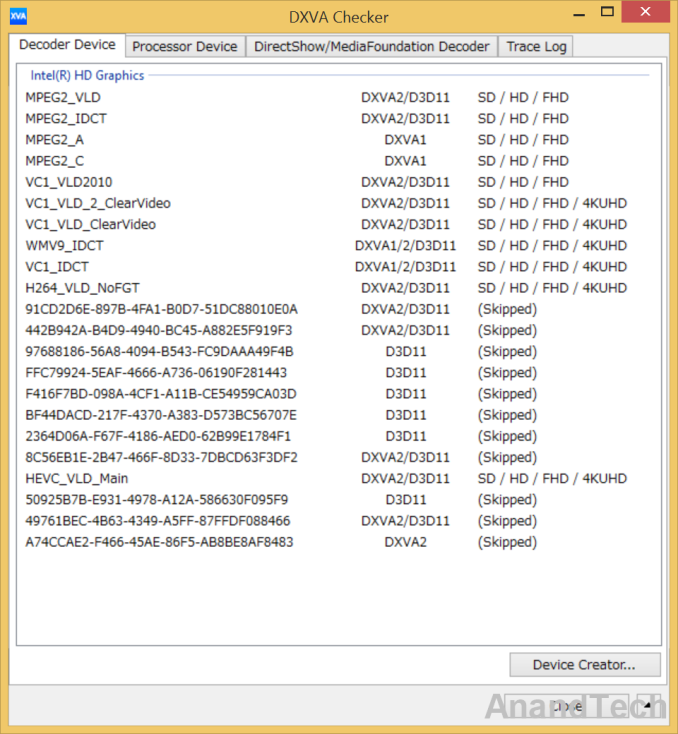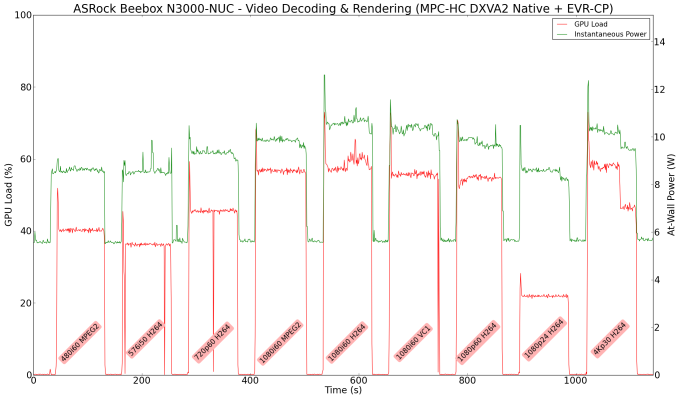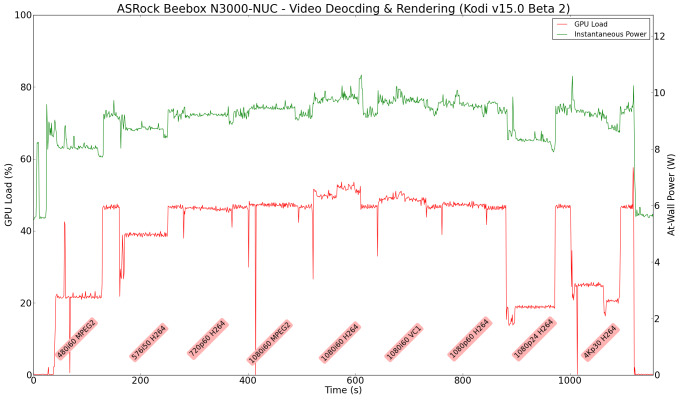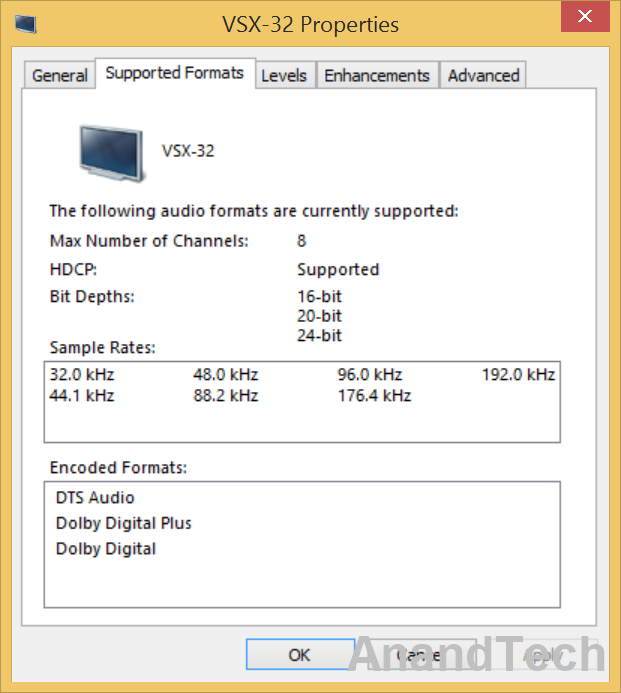ASRock Beebox Review: A Fanless Braswell UCFF PC
by Ganesh T S on July 14, 2015 8:00 AM ESTHTPC Credentials
Given the Beebox's fanless nature and the presence of Intel HD Graphics, we expect many purchasers to use it as a media playback machine / HTPC. Given the specifications, it is quite clear that we are not looking at a madVR capable machine, but one targeted at the entry-level / average HTPC user or someone looking for a HTPC to put in a second or third room (non-primary HTPC). There are two HTPC aspects that we will explore in this section, one related to network streaming (OTT services), and the other related to local file playback. Prior to that, we have a small sub-section dealing with refresh rate accuracy.
Refresh Rate Accurancy
Starting with Haswell, Intel, AMD and NVIDIA have been on par with respect to display refresh rate accuracy. The most important refresh rate for videophiles is obviously 23.976 Hz (the 23 Hz setting). As expected, the ASRock Beebox N3000-NUC has no trouble with refreshing the display appropriately in this setting.
The gallery below presents some of the other refresh rates that we tested out. The first statistic in madVR's OSD indicates the display refresh rate.
Network Streaming Efficiency
Evaluation of OTT playback efficiency was done by playing back our standard YouTube test stream and five minutes from our standard Netflix test title. Since YouTube now defaults to HTML5 for video playback, we have stopped evaluating Adobe Flash acceleration. Note that only NVIDIA exposes GPU and VPU loads separately. Both Intel and AMD bundle the decoder load along with the GPU load. The following graph shows the power consumption at the wall for playback of the HTML5 stream in Mozilla Firefox (v 38.0.5).

GPU load was around 31.74% for the YouTube HTML5 stream and 7.6% for the steady state 6 Mbps Netflix streaming case.
Netflix streaming evaluation was done using the Windows 8.1 Netflix app. Manual stream selection is available (Ctrl-Alt-Shift-S) and debug information / statistics can also be viewed (Ctrl-Alt-Shift-D). Statistics collected for the YouTube streaming experiment were also collected here.

The ASRock Beebox doesn't seem to be the most power-efficient fanless PC available, but it does seem to be the best when it comes to models with replaceable RAM and internal storage.
Decoding and Rendering Benchmarks
Prior to testing out the decoding and rendering performance, we take a look at the DXVA decoding support available via Intel's Braswell GPU drivers.
The above screenshot shows that there is hardware acceleration available for MPEG-2, VC-1, H.264 and HEVC. However, there is no HEVC Main10 support.
In order to evaluate local file playback, we concentrate on EVR-CP and Kodi. We already know that EVR works quite well even with the Intel IGP for our test streams. In our earlier reviews, we focused on presenting the GPU loading and power consumption at the wall in a table (with problematic streams in bold). Starting with the Broadwell NUC review, we decided to represent the GPU load and power consumption in a graph with dual Y-axes. Nine different test streams of 90 seconds each were played back with a gap of 30 seconds between each of them. The characteristics of each stream are annotated at the bottom of the graph. Note that the GPU usage is graphed in red and needs to be considered against the left axis, while the at-wall power consumption is graphed in green and needs to be considered against the right axis.
Frame drops are evident whenever the GPU load consistently stays above the 85 - 90% mark. In addition to tracking that aspect in the graphs below, we also get an idea of the system's power efficiency for decode and playback of some common codecs.
In both cases, the ASRock Beebox / Braswell has no problem in playing back our test streams without frame drops. Note that we have not tested out HEVC decoding and rendering - we still believe that, despite the 4K output capabilities, the core platform needs a more well-rounded set of features before it can be recommended for a 4K HTPC setup. Braswell doesn't have HDMI 2.0 or HDCP 2.2, and can't decode HEVC Main10 profile videos even in hybrid decode mode. However, given the $220 price, it is not a big deal.
HDMI Audio
One of the issues plaguing early Bay Trail-based units was the absence of HD audio bitstreaming support (DTS-HD MA and Dolby TrueHD). Unfortunately, there seems to be a similar issue with Cherry Trail. The Intel drivers for the Beebox don't have HD audio bitstreaming support, and it is not clear when (if at all) Intel would provide Windows drivers with the feature enabled.
It remains to be seen if the Linux case is any different (the OpenELEC beta that I tried late last month didn't run on the Beebox).




















45 Comments
View All Comments
amakula77 - Tuesday, July 14, 2015 - link
This review is good but I think it needs an extra section to test this out as a low end gaming machine , with Bluetooth controller, this thing I'm sure could play older emulators and GOG and older steam games.amakula77 - Tuesday, July 14, 2015 - link
I did not see the Dolphin emulator test this is good by more gaming tests are needed to determine if this will be a suitable low end gaming machinenathanddrews - Tuesday, July 14, 2015 - link
Yeah, I'm thinking there is a missing graphic - normally they publish Dota 2 numbers or something. From Performance Metrics - I "GPU performance shows a similar trend to the CPU performance. The difference when compared to Bay Trail is considerable." But all I see is 3D Mark, where it is marginally faster than the LIVAX. Then on Performance Metrixs - II, it is marginally slower than LIVAX for Dolphin. I guess I'm not seeing anything in the way of GPU improvements from these data points. Did I miss something or is something missing?blakehaas - Tuesday, July 14, 2015 - link
I like the power usage, but the available ports are lacking. The CI320 has esata and a plethora of usb3.0.barleyguy - Tuesday, July 14, 2015 - link
eSata especially is a big advantage. (All of my media is stored a 4 TB eSata hard drive.)Kracer - Wednesday, July 29, 2015 - link
Is eSata that common?A NAS seems a much more universal solution.
Pissedoffyouth - Tuesday, July 14, 2015 - link
I'd like to see an i5 5775c in a box like this especially with the quiet laptop style blowers a lot of newer PC's have.barleyguy - Tuesday, July 14, 2015 - link
Zotac has some pretty powerful boxes similar to this. The EN860 is an i5 4210u with NVidia GTX 860M graphics. They will soon have an EN960 with 970M graphics. The EN860 has a silent cooler (completely silent at idle, and about 35 dB when gaming).They are a lot more expensive though. The EN860 is $500 barebones, and the EN960 will be coming in around $700 barebones.
owarchild - Tuesday, July 14, 2015 - link
@Ganesh T S, can you try this alpha version of OpenELEC: http://forum.kodi.tv/showthread.php?tid=231955&... Is should work on the Beebox as it has been used in a ASRock N3150 board.savagemike - Tuesday, July 14, 2015 - link
I don't understand your pricing comment that 128GB is a nice premium over 32GB for only $20. This also entails the loss of an operating system which costs around $100+ if that is the OS you want.In the same vain I don't understand the pricing of your system. How did you get 4GB/128GB and Windows 8.1 Pro 64 for $220?